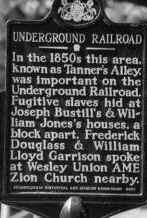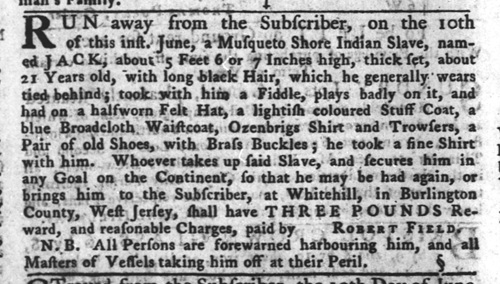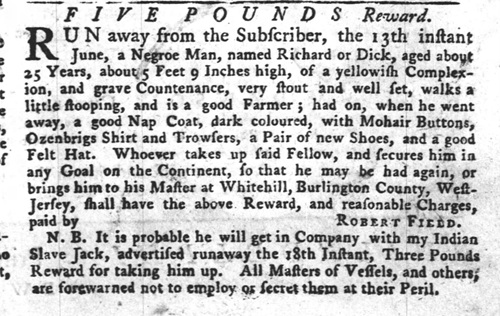
Study Areas
June 1767: Jack, an "Indian Slave" man escapes from Robert Fields in Burlington County.

RUN away from the Subscriber, on the 10th of this inst. June, a Musqueto Shore Indian Slave, named JACK, about 5 Feet 6 or 7 Inches high, thick set, about 21 Years old, with long black Hair, which he generally wears tied behind; took with him a Fiddle, plays badly on it, and had on a halfworn Felt Hat, a lightish coloured Stuff Coat, a blue Broadcloth Waistcoat, Ozenbrigs Shirt and Trowsers, a Pair of old Shoes, with Brass Buckles; he took a fine Shirt with him. Whoever takes up said Slave, and secures him in any Goal on the Continent, so that he may be had again, or brings him to the Subscriber, at Whitehill, in Burlington County, West Jersey, shall have THREE POUNDS Reward, and reasonable Charges, paid by ROBERT FIELDS.
N.B. All Persons are forewarned harbouring him, and all Masters of Vessels taking him off at their Peril.
Notes
The enslaved Jack is described by Robert Fields as an "Indian Slave." Although African Americans are most often associated with systems of colonial enslavement, Indiginous people of the Americas were also enslaved in large numbers by colonists. The enslavement of Native Americans by Europeans in the North American colonies was most common in the decades prior to the mass importation of African slaves, but the practice persisted on a smaller scale into the revolutionary era, as evidenced by this escape notice.
Jack is "a Musqueto Shore" Indian. Although this could refer to the coastal and bayside areas of New Jersey, which were notorious for the heavy infestation of mosquitoes, it is much more likelly that Jack is a Miskito man, a member of the Afro-Indiginous peoples living on what was known as the Mosquito Coast, a land in the Western Caribbean along the coastlines of present day Nicaragua and Honduras. This area was frequently referred to as the Mosquito Shore ("Musqueto Shore") in newspapers of the time period. Escaped African slaves and the survivors of shipwrecked slave ships settled in the area and intermixed with the indiginous Miskito peoples. These mixed race people were named Mosquito Zambo by the Spanish.
The Mosquito Zambo allied themselves with the British in the early 18th century and began raiding neighboring Spanish and unallied settlements. In addition, the British enlisted them to track down and attack the Maroon settlements inland. Captives from these raids and Maroon expeditions were sold as slaves, supplying many workers for the sugar plantations in the Caribbean. Jack, born about 1741, could easily have been one of these captured and enslaved Miskito people.
Enslaved Man Richard Also Escapes

FIVE POUNDS Reward.
RUN away from the Subscriber, the 13th instant June, a Negroe Man, named Richard or Dick, aged about 25 Years, about 5 Feet 9 Inches high, of a yellowish Complexion, and grave Countenance, very stout and well set, walks a little stooping, and is a good Farmer; had on, when he went away, a good Nap Coat, dark coloured, with Mohair Buttons, Ozenbrigs Shirt and Trowsers, a Pair of new Shoes, and a good Felt Hat. Whoever takes up said Fellow, and secures him in any Goal on the Continent, so that he may be had again, or brings him to his Master at Whitehill, Burlington County, West-Jersey, shall have the above Reward, and reasonable Charges, paid by
ROBERT FIELD.
N.B. It is probable he will get in Company with my Indian Slave Jack, advertised runaway the 18th Instant, Three Pounds Reward for taking him up. All Masters of Vessels, and others, are forewarned not to employ or secret them at their Peril.
Three days after Jack escaped, the enslaved Black man Richard also escaped, and Fields placed another ad in The Pennsylvania Gazette, with a note that he expected the two men would meet and travel together. Since both enslaved men had made their escape by June 13th, several days before the advertisement for Jack was published, the question occurs of why Fields only advertised for Jack's return in his first ad and did not mention Richard's escape. It is likely he composed the advertisement for Jack before learning of Richard's escape, and sent it by post or with a friend to be carried from White Hill plantation in New Jersey to the offices of the Gazette in Philadelphia. It missed the deadline to be included in the June 11th edition, and was published in the next edition on June 18th. By then of course, Fields had composed a second advertisement for Richard, which he was able to have published in the June 25th edition.
Both ads continued in publication for several weeks in either The Pennsylvania Gazette or The Pennsylvania Journal. The last ad for Jack was published in the July 2, 1767 edition of the Journal, but the ads for Richard continued. In August, Fields published an updated advertisement in The Pennsylvania Gazette for both men. In this ad he increased the total reward to ten pounds for both or five pounds for either, however the description of Jack's escape changed considerably:
And on the 24th of July, a Musquito-shore Indian, named JACK, about 21 years old, 5 feet and about 6 or 7 inches high, thick set, with long black hair, which he generally wears tied behind; he is a farmer, and had on, a good felt hat, a short yellowish coloured homespun coat, a blue broadcloth waistcoat, without sleeves, ozenbrigs shirt and trowsers, and a pair of good shoes, with steel buckles. He stole and took with him, a good beaver hat, a new fine shirt, and a buff coloured cloth waistcoat, with lapels, and yellow buttons.
The changes in date and clothes worn or taken indicate that Fields had succeeded in capturing Jack sometime in early or mid-July, but the man escaped a second time, on July 24th. The data for Richard remained unchanged, suggesting that Fields had not yet found him. Strangely, the original June ad for Richard continued to be published in The Journal until October 8, 1767, all still including the notation that Fields believed Richard had or would join the missing Jack, for whom the reward still stood at three pounds. There is no indication that Fields ever recovered either man. At his death his estate included six enslaved persons. The newspaper account of his drowning, in January 1775, included the note "he had only his Negro man with him."
Robert Fields, the enslaver of Jack and Richard, appears to be Robert Field II (1723-1775), who inherited White Hill plantation in 1757 from his father and built White Hill Mansion circa 1760. He was married to Mary Peale in 1765, who was widowed and became matriarch of White Hill in 1775 when Robert drowned in the Delaware River. Mary attempted to keep the plantation from damage as war raged over the county. She was visited by American naval captain Houston in 1776, then in December of that year hosted Hessian Captain Wrenden, who made White Hill Mansion his headquarters. Count Carl Emil Kirk Von Donop, a Hessian colonel and commander of Hessian forces near Trenton, wrote an order protecting the plantation from raids.
Mary Peale Field married American Commodore Thomas Read in 1779. That same year she assisted American Commodore John Barry in escaping capture by British forces.
Sources
The Pennsylvania Gazette, 18, 25 June, 27 August 1767.
The Pennsylvania Journal, or Weekly Advertiser, 25 June, 08 October 1767.
The Pennsylvania Evening Post, 25 June, 04 February 1775.
Frank Griffith Dawson, "William Pitt’s Settlement at Black River on the Mosquito Shore: A Challenge to Spain in Central America, 1732-87," Hispanic American Historical Review (1983) 63 (4): 677–706. Online at https://doi.org/10.1215/00182168-63.4.677, accessed 23 June 2025.
The Friends of White Hill Mansion, https://www.whitehillmansion.org/history, accessed 23 June 2025.
 Covering the history of African Americans in central Pennsylvania from the colonial era through the Civil War.
Covering the history of African Americans in central Pennsylvania from the colonial era through the Civil War.
Support the Afrolumens Project. buy the books on Amazon:
The Year of Jubilee, Volume One: Men of God
The Year of Jubilee, Volume Two: Men of Muscle

